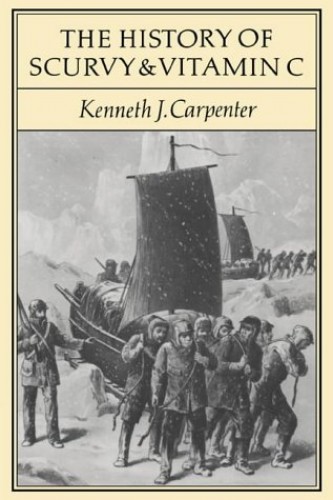Code PNT-1 / 85 mg. / Price: $4.95

ack in 2004, I posted
Chapter 4 of Meditopia, which includes
a special section entitled, "A Short History of Scurvy And the Suppression of Hypoascorbemia."
A major point of the work is that most people are suffering from this condition, "hypoascorbemia" -- that is to say,
subclinical Vitamin C deficiency. Few people appreciate this, and most doctors are oblivious.
 Chapter 4, Section 3
Chapter 4, Section 3 discusses
the historical use
of pine needles to cure what we would now call Vitamin C deficiency:

 The time frame within which the scurvy is usually thought in the West as having been an epidemiological problem
is roughly sixteenth to eighteenth century, but the many of the important parts of the story can be found outside
these chronological boundaries.
The time frame within which the scurvy is usually thought in the West as having been an epidemiological problem
is roughly sixteenth to eighteenth century, but the many of the important parts of the story can be found outside
these chronological boundaries.
 Vogel begins his work by retelling of Jacques Cartier and the bitter
winter of 1535-36. [ 4 ] His three ships were
frozen in the St. Lawrence River, near what is now Montreal, and
with four feet of ice beneath them and the extinction of fresh food within the ship holds. Scurvy soon set in so
severely that by mid-March, 25 men had died, and within the remainder, only "three or foure" men were not so ill
as to be considered hopeless. However, with the help of a local Indian chief, Domagaia, (who had himself once cured
himself of scurvy -- a questionable appendage to the story, since scurvy was almost unheard of among the Indians),
"the juice and sappe of a certain Tree," saved the remaining men.
Vogel begins his work by retelling of Jacques Cartier and the bitter
winter of 1535-36. [ 4 ] His three ships were
frozen in the St. Lawrence River, near what is now Montreal, and
with four feet of ice beneath them and the extinction of fresh food within the ship holds. Scurvy soon set in so
severely that by mid-March, 25 men had died, and within the remainder, only "three or foure" men were not so ill
as to be considered hopeless. However, with the help of a local Indian chief, Domagaia, (who had himself once cured
himself of scurvy -- a questionable appendage to the story, since scurvy was almost unheard of among the Indians),
"the juice and sappe of a certain Tree," saved the remaining men.
 The branches from this "magical tree" were first gathered and then "boiling
bark and leaves for a decoctain, and placing the dregs upon the legs." All those who were treated "rapidly recovered
their health and the Frenchmen marveled at the curative skill of the natives." We now know that the CURE used was
nothing more than hemlock or white pine.
The branches from this "magical tree" were first gathered and then "boiling
bark and leaves for a decoctain, and placing the dregs upon the legs." All those who were treated "rapidly recovered
their health and the Frenchmen marveled at the curative skill of the natives." We now know that the CURE used was
nothing more than hemlock or white pine.
 Far from being a obscure story, it is James Lind, himself, credited in
the West with "discovering" the dietary basis for curing scurvy (which we'll review in a moment),
who launched his experiments proving thus, but only AFTER he read of Cartier's account.
[ 5 ]
Far from being a obscure story, it is James Lind, himself, credited in
the West with "discovering" the dietary basis for curing scurvy (which we'll review in a moment),
who launched his experiments proving thus, but only AFTER he read of Cartier's account.
[ 5 ]
Pine Needles & Shikimic Acid


Recently, interest in pine needles, specifically the common practice
of making tea from the needles using decoction with boiled water, has been renewed. The focus now, however,
has been on the use of pine needle tea to take advantage of its high
shikimic
acid content,
which has unique medical properties,
but which must be taken with care.

Shikimic acid is not the only
source of shikimic acid. In fact, commercial grade shikimic acid is usually made from Chinese star anise -- from
which we sell the
essential oil.

The most prominent discussions now about shikimic acid center on its ability to
halt spike protein transmission, a problem
now arising
as an integral part of the current vaccine rollout.
In fact, it is the spike proteins that are reportedly causing
vascular damage in those receiving the injections.
Some are suggesting that shikimic acid be used
as a form
of protection by the unvaccinated from those who have any one of the current approved mRNA vaccine, which noted virologist, Dr. Judy Mikovits has indicated
could kill millions.
The noted nutritional authority, David Wolf,
has gone so far as
to incorporate pine needle tea
into a long laundry list of natural products which he recommends that people take if they wish to protect themselves from vaccinated people who are
shedding the dreaded spike proteins.
 Our Conclusion:
Our Conclusion: From my reading of the literature, I believe it is premature to push pine needle
tea as an mRNA vaccine panacea. As of this writing, the vaccines haven't even been out for a year.
Pine needle tea should be consumed because of its well-established properties -- medical properties that have been known and accepted
for centuries. When more convincing literature is made available, we will publish it on our website.

Recommended video links:
- 15 Notable Health Benefits -- Well worth watching.
- How to Brew Pine Needle Tea -- Benefits of pine needle tea discussed.
This YouTuber's method of brewing begins at 2:35.
- How I Make Pine Needle Tea -- Interesting input from North Carolina Prepper.
- How to Make Pine Needle Tea -- From YouTuber Holistic Prepper -- The quick
version. Just 1:56. If time is an issue for you, follow this video.
- Wild Edible Plants: Pine Needle Tea -- From YouTuber, Animal Man Survivor.